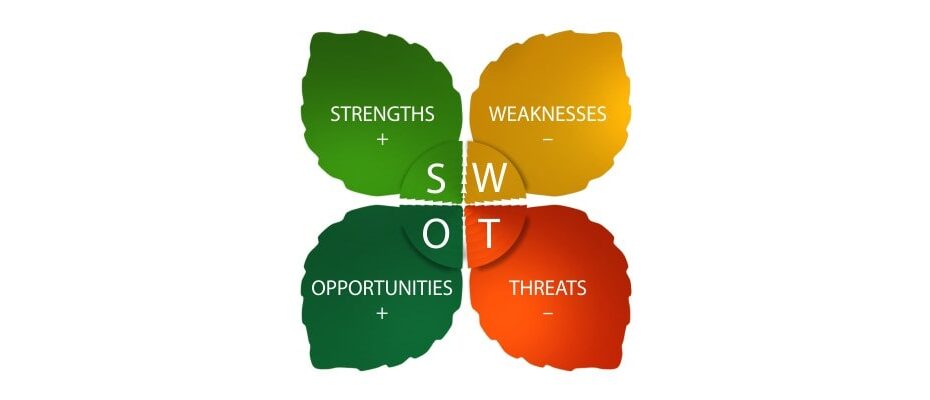The event organizers often focus on logistics issues, recognizing that this is a key determinant of the event’s success. However, while no event can be successful without good logistics, it is not the purpose of the event itself. It is a one – among the others – of the key elements in the process of organizing events. First of all, when organizing an event – conference, workshop, training course – we plan goals we want to achieve. Therefore, the success of the event means we accomplished the goals set for it (about the SMART goals in the event industry we wrote in earlier posts).
While planning the event, it is worth to use the SWOT analysis – a simple tool to assess the strengths, weaknesses, opportunities and risks associated with the project. This analysis can be successfully used in planning events such as conferences, workshops or training courses.
What does a „SWOT” mean?
“S” stands for Strengths
“W” stands for Weaknesses
“O” stands for Opportunities
“T” stands for Threat
Strengths
These are the features of the project (conference, workshop, training course) that can contribute to the project’s goal. Think about what is a strong feature of your event.
Examples of strengths:
- Exceptional lecturers – if you organize an event and you can offer its attendees contact with someone who is an authority in a given industry, it will certainly be your strongest asset.
- Experienced and motivated team – working with people who know what to do and at the same time work with commitment – regardless of whether they are volunteers or professional event coordinators – increases the chance of success of the event.
- Effective solutions for event management – an efficient online event registration and payment processing system certainly supports the success of the event.
- Effective tools for the promotion of events – if you operate in the event industry, you already know that without marketing in the social media promotion isn’t really possible.
Weaknesses
These are the features of the project that can prevent you from achieving your goals. Think about the weaknesses of your event.
Examples of weaknesses:
- Lack of sufficient financing for the event – organizing events with the insufficient budget may contribute to its failure. Check if you have the right buffer in case of unforeseen expenses.
- Inexperienced event team – if there is a large staff turnover in your event team, this is definitely a weak side. You have to start working on it ASAP. There is nothing worse for an event than an inexperienced, uninformed employee on the first line of contact with your client.
- Inefficient registration and event management system – check whether the system you use is efficient. If it hangs up, runs slowly, loses data, can’t handle immense Internet traffic or is complicated, it is time to change it.
Opportunities
These are external factors that can be helpful in achieving project goals.
Examples of Opportunities:
- Little competition – if you operate in a niche market, you have the chance to strengthen your position and prepare for the times when your competitors become strong.
- Favorable economic conditions – the market situation is your ally, use it to prepare for potential “bad times”.
- Support from local authorities – if you have the opportunity to cooperate with local governments or local respected NGO’s it is great! Use this chance to work on the image of both, the event and your company.
Threats
These are external factors that may prove detrimental to the achievement of the project’s goals.
Examples of threats:
- Strong competition – this isn’t a reason to give up organizing events in a given industry, but it can be a significant factor affecting the achievement of your goal.
- Bad weather – this is a particularly serious threat when organizing an outdoor event.
- Unprepared infrastructure – choosing the place of the event, which is still “under construction”, but for the time of the event is to be ready, may expose you to Murphy’s merciless law.
SWOT in practice
First of all – identify the strengths and weaknesses of your event and also the opportunities that you can use and the threats that can stand in the way of achieving your goal.
Secondly – put the collected information in the table (you can easily find free SWOT analysis templates on the Internet).
Thirdly – answer the questions:
- Will you be able to use indicated strengths to take advantage of the opportunities?
- Will it be easier to overcome the threats thanks to the indicated strengths?
- Do the indicated weaknesses prevent you from seizing opportunities?
- Do the indicated weaknesses expose the event to threats?
Fourthly – start planning.
***
Thanks to the SWOT analysis, you will get the important information you need to effectively plan the event. It is very important to carry out this analysis BEFORE developing a plan for the event. This will enable the development of an appropriate strategy that will maximize the potential of strengths and project opportunities while minimizing the impact of vulnerabilities and threats.
If you are ready to organize your event, use a reliable and proven event registration software







